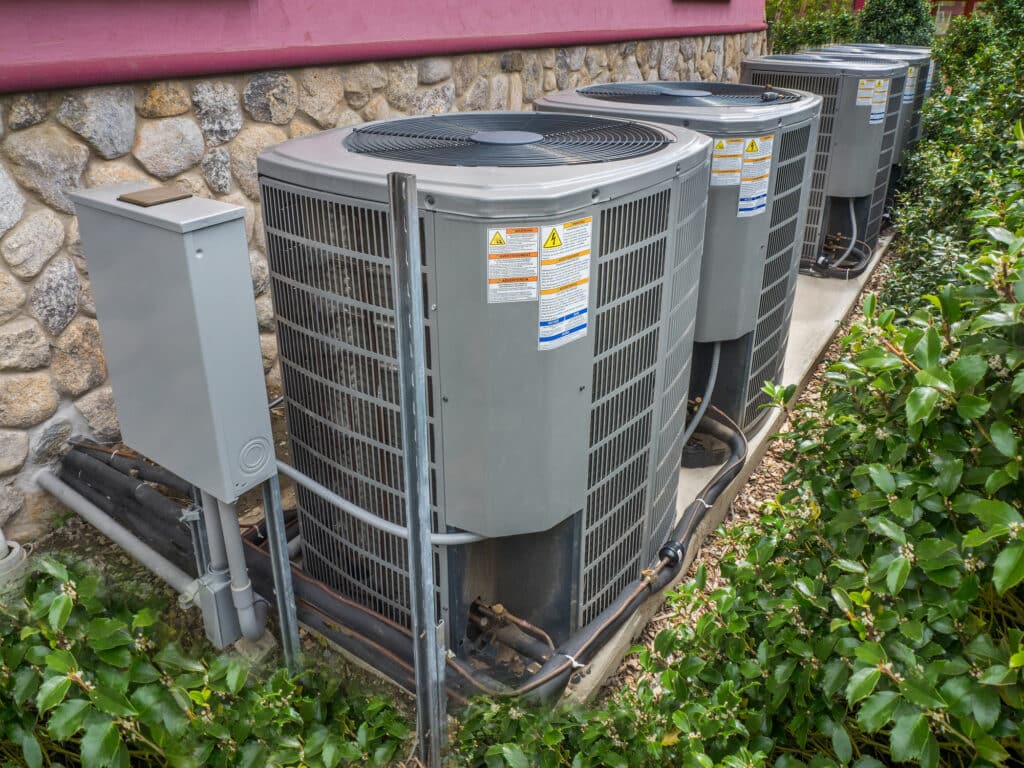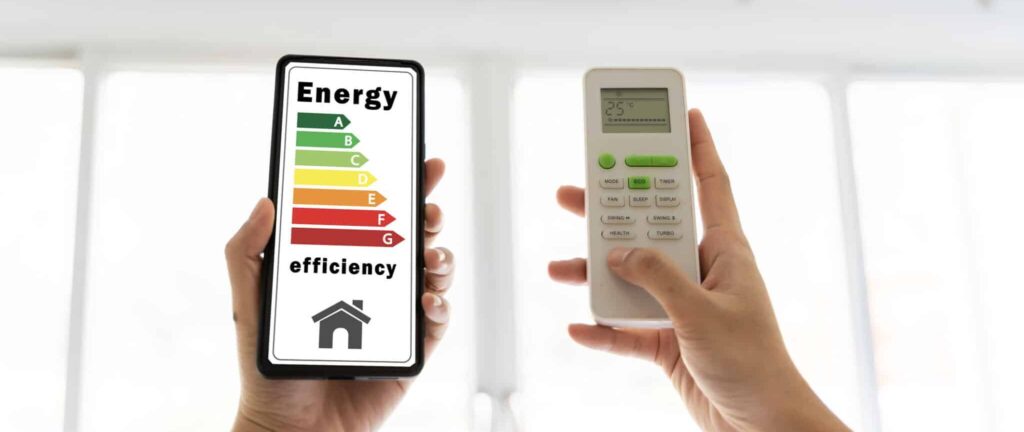
Top Energy-Efficient HVAC Options for Your Home
Are you looking to reduce your home’s energy consumption and save on utility bills?
Energy-efficient HVAC systems could be the solution you’re seeking. With rising energy costs and growing environmental concerns, upgrading to an energy-efficient heating, ventilation, and air conditioning (HVAC) system is more important than ever. In this guide, we’ll explore the benefits of energy-efficient HVAC systems, the key metrics to consider, and the top technologies available today.

Importance of Energy-Efficient HVAC
Energy efficiency in HVAC systems plays a crucial role in reducing energy consumption and lowering utility bills. Efficient systems use less energy to achieve the same level of comfort, making them an environmentally friendly option that also saves you money. In addition, energy-efficient systems tend to have longer lifespans and require less maintenance, providing further cost savings over time.
Benefits of upgrading to energy-efficient systems
Upgrading to an energy-efficient HVAC system offers numerous benefits, including:
- Lower energy bills: Reduced energy consumption translates to lower monthly utility costs.
- Improved comfort: Advanced systems provide better temperature control and air quality.
- Environmental impact: Using less energy helps reduce your carbon footprint.
- Increased home value: Energy-efficient upgrades can boost your property’s market value.
Understanding Energy Efficiency in HVAC
What is an Energy-Efficient HVAC?
Energy efficiency in HVAC systems refers to the ability to provide heating and cooling using the least amount of energy. It’s a measure of how well an HVAC unit converts energy into comfort. High-efficiency systems are designed to use less energy to maintain desired indoor temperatures, reducing overall energy consumption and lowering utility bills.
Key metrics (SEER, EER, HSPF, AFUE)
Several key metrics are used to evaluate the energy efficiency of HVAC systems:
- SEER (Seasonal Energy Efficiency Ratio): SEER measures the efficiency of air conditioners and heat pumps during the cooling season. A higher SEER rating indicates greater energy efficiency.
- EER (Energy Efficiency Ratio): EER evaluates the efficiency of air conditioners at peak cooling performance, typically at a specific outdoor temperature. Higher EER ratings mean better efficiency.
- HSPF (Heating Seasonal Performance Factor): HSPF measures the efficiency of heat pumps during the heating season. Like SEER, a higher HSPF rating signifies greater efficiency.
- AFUE (Annual Fuel Utilization Efficiency): AFUE measures the efficiency of furnaces and boilers. It represents the percentage of fuel converted into usable heat. Higher AFUE ratings indicate more efficient units.
How these metrics impact performance and cost
Understanding these efficiency metrics is crucial for making informed decisions when selecting an HVAC system. Here’s how they impact performance and cost:
- Performance: High-efficiency systems provide consistent and reliable heating and cooling, maintaining comfortable indoor temperatures regardless of external conditions. They often feature advanced technology that enhances performance, such as variable-speed motors and smart thermostats.
- Cost: While high-efficiency HVAC systems typically have higher upfront costs, they offer significant long-term savings. Reduced energy consumption lowers monthly utility bills, and many energy-efficient systems qualify for rebates and tax incentives. Additionally, these systems often have longer lifespans and require less maintenance, further reducing costs over time.
Top Energy-Efficient HVAC Technologies
Overview of Modern Energy-Efficient HVAC technologies
The HVAC industry has seen significant advancements in recent years, leading to the development of highly energy-efficient technologies. These innovations not only enhance comfort but also reduce energy consumption and operational costs. Let’s explore some of the most popular energy-efficient HVAC technologies available today.
Benefits and drawbacks of each
- Energy-Efficient Air Conditioners:
- Benefits: High SEER ratings (up to 26 SEER in some models), improved cooling performance, and lower energy bills.
- Drawbacks: Higher initial costs and potential for more complex maintenance requirements.
- High-Efficiency Heat Pumps:
- Benefits: Versatile for both heating and cooling, excellent efficiency with HSPF ratings above 10, and can significantly reduce energy consumption compared to traditional heating methods.
- Drawbacks: Higher upfront costs and may require a backup heating system in extremely cold climates.
- Energy-Efficient Furnaces:
- Benefits: High AFUE ratings (up to 98%), providing almost complete fuel efficiency. Ideal for cold climates and can significantly lower heating costs.
- Drawbacks: Higher initial investment and potential for increased maintenance costs over time.
- Smart Thermostats and HVAC Systems:
- Benefits: Allows precise temperature control, can learn your schedule and adjust settings automatically, integrates with home automation systems, and can be controlled remotely via smartphone apps.
- Drawbacks: Higher upfront costs and may require professional installation and setup.
- Ductless Mini-Split Systems:
- Benefits: High efficiency, flexible installation, individual room control, and no ductwork required, reducing energy losses.
- Drawbacks: Higher installation costs per unit and might be less effective in extremely large spaces without multiple units.
- Geothermal Heating and Cooling Systems:
- Benefits: Extremely high efficiency, renewable energy source, long-term savings, and environmentally friendly.
- Drawbacks: Very high initial installation costs and requires sufficient land for ground loops.
- Solar-Powered HVAC Systems:
- Benefits: Uses renewable solar energy, reduces electricity costs, and can provide energy independence.
- Drawbacks: High upfront costs for solar panels and HVAC integration, and dependent on sunlight availability.
High Energy-Efficiency Heat Pumps
Types Of Heat Pumps
Heat pumps are versatile systems that provide both heating and cooling, making them an excellent energy-efficient option for many homes. There are two main types of high-efficiency heat pumps: air-source and geothermal.
- Air-Source Heat Pumps: These systems transfer heat between your home and the outside air. Modern air-source heat pumps are highly efficient and can provide adequate heating even in colder climates. They are easier to install and less expensive upfront compared to geothermal systems.
- Geothermal Heat Pumps: Also known as ground-source heat pumps, these systems transfer heat between your home and the ground. They are incredibly efficient because the ground temperature remains relatively constant year-round. While they have higher installation costs due to the need for underground piping, they offer significant long-term savings.
Cost vs. savings analysis
While high-efficiency heat pumps come with higher upfront costs, they offer substantial savings over time. Here’s a cost vs. savings analysis:
- Initial Costs:
- Air-Source Heat Pumps: Typically range from $4,000 to $8,000, including installation.
- Geothermal Heat Pumps: Installation costs range from $10,000 to $30,000, depending on the system size and ground conditions.
- Operational Savings:
- Energy Savings: High-efficiency heat pumps can reduce energy usage by 30-50% compared to traditional heating and cooling systems. This translates to lower monthly utility bills.
- Maintenance Costs: Heat pumps generally require less maintenance than systems that rely on combustion, reducing long-term service costs.
- Long-Term Benefits:
- Geothermal Systems: Despite higher initial costs, geothermal systems can save homeowners 30-70% on heating and 20-50% on cooling annually. With a lifespan of 25 years for indoor components and 50+ years for ground loops, the long-term savings are substantial.
- Air-Source Systems: Provide more immediate payback due to lower installation costs and significant energy savings, especially with high HSPF and SEER ratings.

Smart Thermostats and Energy-Efficient HVAC Systems
Role Of Smart Thermostats In Energy Savings
Smart thermostats play a crucial role in enhancing energy-efficient HVAC systems. These devices allow homeowners to control their heating and cooling systems more precisely, leading to significant energy savings.
Smart thermostats learn your schedule and preferences, automatically adjusting the temperature to optimize comfort and efficiency. By minimizing energy use when you’re not home or asleep, these thermostats can reduce your utility bills substantially.
Integration with HVAC systems
Modern smart thermostats integrate seamlessly with various HVAC systems, providing advanced features that enhance overall system performance. Key integration benefits include:
- Remote Control: Use smartphone apps to monitor and adjust your HVAC system from anywhere, ensuring you never heat or cool an empty home.
- Energy Reports: Many smart thermostats provide detailed energy usage reports, helping you identify patterns and opportunities for further savings.
- Learning Algorithms: Devices like the Nest Learning Thermostat use algorithms to learn your schedule and preferences, making automatic adjustments to maximize efficiency.
- Geofencing: This feature detects when you leave or approach your home, adjusting the temperature accordingly to save energy while maintaining comfort.
- Integration with Smart Home Systems: Smart thermostats can be integrated with other smart home devices and systems, such as Amazon Alexa, Google Assistant, and Apple HomeKit, allowing for voice control and creating a cohesive smart home environment.
Best Smart Thermostat Options
Here are some of the best smart thermostats available, known for their energy-saving features and seamless integration with HVAC systems:
- Nest Learning Thermostat:
- Features: Learning algorithm, remote control via app, energy usage reports, geofencing, voice control compatibility.
- Benefits: Automatically adjusts based on your schedule and preferences, is easy to use, and provides substantial energy savings.
- Ecobee SmartThermostat with Voice Control:
- Features: Built-in Amazon Alexa, remote sensors for room-specific control, energy usage reports, and learning capabilities.
- Benefits: Comprehensive smart home integration, room-specific comfort, and detailed energy insights.
- Honeywell Home T9 Smart Thermostat:
- Features: Smart room sensors, geofencing, customizable scheduling, remote control via app, voice control compatibility.
- Benefits: Balances comfort throughout the home, easy installation, and user-friendly interface.
- Emerson Sensi Touch Wi-Fi Smart Thermostat:
- Features: Touchscreen display, remote access via app, energy usage reports, geofencing, voice control compatibility.
- Benefits: Budget-friendly, simple installation, and effective energy management.
Energy-Efficient HVAC: Ductless Mini-Split Systems
How they work
Ductless mini-split systems, often simply referred to as mini-splits, provide heating and cooling without the need for ductwork. These systems consist of an outdoor compressor unit and one or more indoor air handling units. The outdoor and indoor units are connected by a conduit that houses the power cable, refrigerant tubing, suction tubing, and a condensate drain.
Key components and operation:
- Outdoor Unit: Contains the compressor, condenser, and expansion valve. It transfers heat between the inside and outside of the home.
- Indoor Units: Mounted on walls or ceilings, these units blow conditioned air directly into the living space. Each indoor unit is typically connected to its own thermostat, allowing for individual temperature control.
- Conduit: Connects the indoor and outdoor units, carrying refrigerant and allowing the transfer of heat.
Energy-Efficiency Benefits
Ductless mini-split systems offer several energy efficiency benefits:
- No Duct Losses: Traditional ducted systems can lose up to 30% of energy through leaks and poor insulation in the ductwork. Mini-splits eliminate this issue by delivering air directly into the room.
- Zoned Heating and Cooling: Each indoor unit can be controlled independently, allowing for customized temperatures in different rooms. This zoned approach avoids heating or cooling unoccupied spaces, resulting in significant energy savings.
- Inverter Technology: Many mini-split systems use inverter technology, which adjusts the compressor speed based on the cooling or heating demand. This continuous adjustment helps maintain a consistent temperature and improves energy efficiency.
- High SEER and HSPF Ratings: Ductless mini-split systems often have high SEER (Seasonal Energy Efficiency Ratio) and HSPF (Heating Seasonal Performance Factor) ratings, indicating superior efficiency compared to conventional systems.
- Variable Speed Compressors: Unlike traditional systems that turn on and off frequently, mini-splits with variable speed compressors run continuously at low power, reducing energy consumption and wear and tear on the system.
Energy-Efficient HVAC: Ideal Use Cases
Ductless mini-split systems are particularly suitable for:
- Homes without Ductwork: Ideal for older homes or additions where installing ductwork would be impractical or too expensive.
- Room Additions and Conversions: Perfect for spaces like garages, basements, or attics that are being converted into living areas.
- Zoned HVAC Systems: Provides targeted heating and cooling to specific areas of a home, such as individual bedrooms or living spaces, enhancing comfort and efficiency.
- Energy-Efficient Upgrades: Excellent for homeowners looking to improve the energy efficiency of their home without a major renovation.
- Supplemental Heating and Cooling: Can be used in conjunction with existing HVAC systems to provide additional comfort in problem areas that are difficult to heat or cool.
Energy-Efficient HVAC: Geothermal Heating and Cooling Systems
How geothermal systems function
Geothermal heating and cooling systems, also known as ground-source heat pumps, utilize the stable temperature of the earth to heat and cool your home. These systems transfer heat between your home and the ground through a series of underground pipes filled with a water-based solution. Here’s a breakdown of how they work:
- Heat Absorption: In the winter, the fluid in the underground pipes absorbs heat from the ground.
- Heat Exchange: The heat pump transfers this absorbed heat into your home.
- Cooling Mode: In the summer, the process reverses. The heat pump removes heat from your home and transfers it into the ground.
Components:
- Ground Loop: The system of pipes buried in the ground. There are two main types: closed-loop (which circulates the same fluid) and open-loop (which uses groundwater).
- Heat Pump Unit: Located inside the home, it extracts heat from the fluid and distributes it through the home’s ductwork or radiant heating system.
- Distribution System: The existing ductwork or radiant floor system that distributes the heat or cooled air throughout your home.
Long-term savings and environmental impact
Geothermal systems offer substantial long-term savings and are highly environmentally friendly. Here’s why:
- Energy Efficiency: Geothermal systems can achieve efficiencies of 300-600% on the coldest winter nights, compared to 175-250% for air-source heat pumps. This efficiency translates into lower energy bills, with savings of up to 70% on heating and 50% on cooling costs.
- Durability and Maintenance: Geothermal systems have fewer moving parts than traditional HVAC systems and are protected from the elements. The indoor components typically last about 25 years, while the ground loop can last over 50 years. This longevity reduces replacement and maintenance costs.
- Environmental Benefits: Geothermal systems produce no direct greenhouse gas emissions, significantly reducing your home’s carbon footprint. By using renewable thermal energy from the ground, they also reduce reliance on fossil fuels.
- Rebates and Incentives: Many governments and utility companies offer rebates and tax incentives for installing geothermal systems, helping offset the initial investment.
Installation considerations
Installing a geothermal system requires careful planning and professional expertise. Here are key considerations:
- Site Evaluation: A professional assessment of your property is necessary to determine the suitability for a geothermal system. Factors include soil conditions, land availability, and the presence of groundwater.
- System Sizing: Properly sizing the system is crucial for efficiency and comfort. An HVAC professional will perform a detailed load calculation to determine the appropriate size.
- Installation Costs: While geothermal systems have higher upfront costs, ranging from $10,000 to $30,000, the long-term energy savings and potential incentives can make them a cost-effective choice over time.
- Ground Loop Options: Depending on your property, you can choose from horizontal loops (requiring more land but less depth), vertical loops (requiring less land but deeper drilling), or pond/lake loops (if you have a suitable water body nearby).
- Professional Installation: Due to the complexity of geothermal systems, professional installation is essential. Look for certified geothermal installers with experience in your area.
Frequently Asked Questions
-
What is the most energy-efficient HVAC system for my home?
The most energy-efficient HVAC system depends on your specific needs and home conditions. Generally, geothermal heat pumps and high-SEER air conditioners are among the most efficient options. Geothermal systems leverage stable ground temperatures for heating and cooling, while high-SEER air conditioners use advanced technology to maximize efficiency.
-
How much can I save by switching to an energy-efficient HVAC system?
Switching to an energy-efficient HVAC system can save you between 20% to 50% on your heating and cooling costs, depending on the system you choose and your current energy usage.
-
Are there any incentives or rebates for installing energy-efficient HVAC systems?
Yes, many local, state, and federal programs offer incentives and rebates for installing energy-efficient HVAC systems. These can include tax credits, utility rebates, and financing options that help offset the initial installation costs. Check with your local utility company and government websites for available programs.
-
How often should I maintain my energy-efficient HVAC system?
Regular maintenance is crucial to keep your energy-efficient HVAC system running smoothly. It’s recommended to schedule professional servicing at least once a year for both heating and cooling systems. Additionally, replace filters every 1-3 months, clean the system’s components, and ensure the outdoor unit is free from debris.
-
Can I install an energy-efficient HVAC system in an older home?
Yes, energy-efficient HVAC systems can be installed in older homes. Options like ductless mini-split systems are particularly suitable for homes without existing ductwork. For more extensive upgrades, such as geothermal systems, a professional assessment can determine the best approach for installation and energy efficiency improvements.







